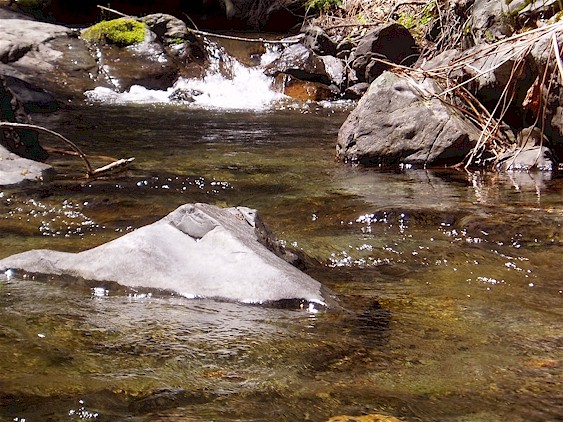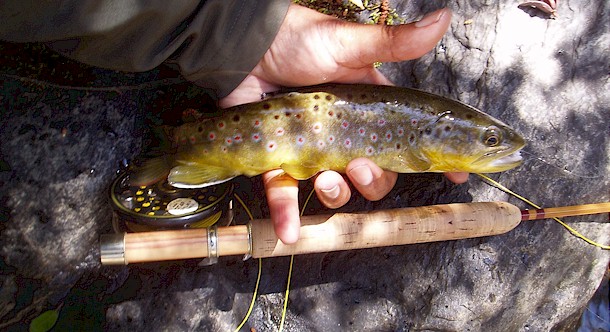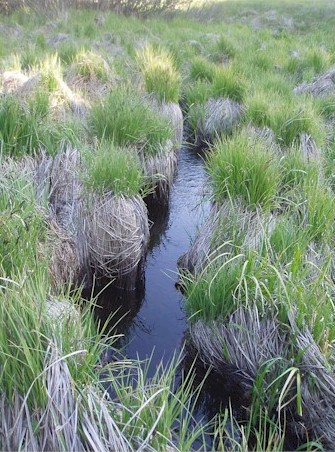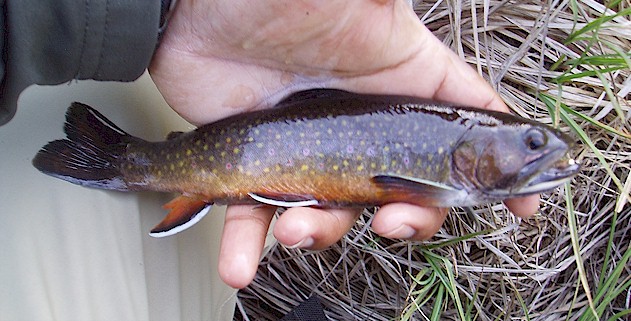|
|
|
|
|
May 5, 2007 - Butterball Creek, North Green Creek, Gutter Creek
Time:
11:00am - 3:00pm Butterball, 5:30 Ė 5:45 North Green Creek, 6:15 Ė 6:45
Gutter Creek Narrative:
In a deep, unnamed canyon on the western slope of the Sierra Nevada Mountains flows a small spring creek. Not a typical spring creek; the flows of this creek are not smooth and serene but are instead swift and raucous. The stream is a mystery of sorts. The USGS lists the stream as ďintermittentĒ, meaning it is feed by spring snow melt and dries up in summer. A fly fishing ranger even told me as much. And yet, there are the fish. Brown Trout to be exact; healthy Brown Trout whose size belie their habitat. Brown Trout that on previous trips, appear to inhabit the stream in fairly good numbers. I showed the ranger my pictures and made him a believer. That would come later- while on my way to North Green and Gutter Creeks. Two creeks I freely mention here because they would be of little interest to the average angler. Small and extremely brushy, these two creeks scream frustration to all but the most ardent small stream fly fisher. Butterball Creek
would be of interest to not only fly fishers but also bait fishers as the
brand new package of Eagle Claw hooks I found would attest. Small, slightly
brushy, with clear water and largish, spooky trout, Butterball Creek
presents a challenge any small stream fly fisher would readily accept.
This year the trail was mostly clear of snow. From the trail head to the stream, the tops of the trees remain at a constant level despite the drop in altitude experienced by those on Terra Firma. It is an amazing transition. Slowly, the Ponderosa Pine, White Fir and Incense are replaced by larger and larger trees until you are descending beneath a canopy of great Giant Sequoia. A shrinking sensation takes hold as the widths of the trees grow and the trail narrows. Within the first 20 minutes you can hear the stream as the trail skirts the edge of the canyon. If you squint, you can imagine that you see the reflection of sunlight off the water but it isnít until youíve passed the land of giants that the trail and stream meet. The water was a brisk 39 degrees. A small storm cloud held back the warming rays of the sun which fill the canyon on most mornings. The cloud was just large enough to prevent the early warming of the water and as the clouds broke up I made my way upstream. Fishing Butterball Creek is best done by presenting a dry fly or nymph to sighted fish. A dry fly during normal flows and a nymph during high water are all it takes but sight fishing is important and the fly has to be presented dead center of fishesí feeding lane. Two inches to either side and a fish will very likely ignore the fly. The stream is somewhat brushy but in spring, before the plants sprout leaves and the flowers have bloomed, the brush is bearable. Thereís a small trail beside the stream which this year appeared to be a little too well defined. I blind fish through the first half dozen holding areas. The fish which are normally in plain sight, were no where to be seen. I fished through 4 areas which are normally fish producers before seeing a single fish. I scared this fish from cover as I crossed the stream. This was somewhat encouraging. I make my way up to the one portion of stream that has always given up large fish. Iíve always thought of it as the big fish hole and this year it appeared all but empty. I spooked another fish in the run below; the big fish lie produced nothing. Iím not sure why. I suppose it could be the full moon or the water temps or perhaps I was being clumsy. Even so, I would have expected to see more fish. Above the big fish section I finally spot my first active trout. It sits in the pressure cushion above a large rock in a smooth glide. The water is slowish and sun shines down on the entire pool. It looks warm and as I watch, the fish sips something off the surface. I keep as low as possible and slowly slide on my butt into casting position. I stop and watch the fish a little longer before beginning to strip line from my reel. I stop again. To much motion might spook this fish and I don't want to miss my first real opportunity of the day. Keeping the rod tip low, I gather the line in the palm of my hand and make a bow and arrow cast. I worry I might spook the fish by casting above it so I make my first cast to the left and slightly behind the fish. I use this tactic often on intimate waters where I know the fish are particularly sensitive to motion. The idea is that the fish will sense the falling fly on their lateral line and swing around to grab it. The fly lands a little short of where I want. It dead drifts for two seconds before shooting down the left hand side of the rock. That doesnít matter. The fish has seen the fly and chases it into the fast water. A quick grab and slight raise of my rod and I land my trout of the season.
Iíd like to say that this scenario plays out again but I send my only other opportunity to catch an active fish scurrying for cover as soon as I raise my rod. I wonít get to cast to another sighted fish the rest of the day. The next few hours, I make my way up the canyon further than I have in previous years. I find some beautiful water but few fish. In one run, after releasing a second fish I catch by blind casting, I stand perfectly still for several minutes. Two fish came out from under a tree, saw me and shot for cover. I hadnít moved. Apparently, I donít make a very good tree. In
late afternoon I quickly make my way to North Green and Gutter Creeks.
Both are small brushy creeks, that would be nice for a quick fix but arenít
what one would consider a destination stream. There are far better streams
in the park that require less effort to fish. North Green creek requires a short hike and a lot of bushwhacking. No sooner do I reach the creek than I have to turn right around and hike back. I donít want to get caught after dark in the middle of nowhere. This allows for a quick 15 minutes of fishing. My first cast is taken by a small fish and met with a long distance release. A systematic approach to the pool and concentration on a good drift results in a second larger fish a short time later. It is another Brown Trout and I release it and quickly head back up the trail. On my way back I find myself at the bottom end of a meadow through which Gutter Creek flows. Free from the cover of the forest, twilight is still an hour away. Gutter Creek is almost impossible to fish it is so brushy. To make things a little more challenging, it is quite marshy as well. The key to fishing the stream appears to be to find the main stream channel as it flows through those portions of the marsh not choked by trees and shrubs. This is more difficult than it sounds and almost dangerous. The main channel is about 12 inches wide and 2 to 3 feet deep. Itís difficult to determine which of the many small channels makes up main stream until you are right up on it. One could easily step down into this channel unexpectedly and wrench a knee or worse. Moving cautiously, I find one short section that surrenders close to a half dozen brook trout in twice as many casts. Healthy brook with a nice dark, almost artic char look to them. Eventually, tired of fighting the mounds of tall grasses that make up the bog, I hike leisurely up the trail to the closest campground and back to the car. I had a full day with a modicum of success but fun none the less. I'm glad to be back in my beloved mountains.
Previous
Yosemite / Ansel Adams Wilderness Chronicle
|





